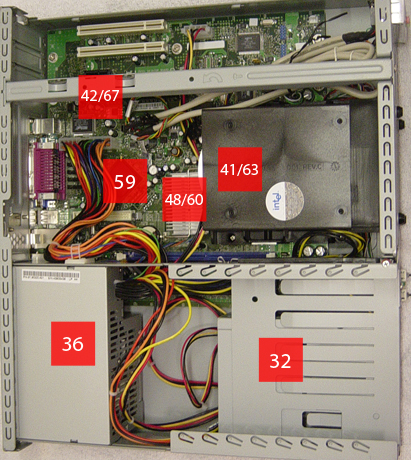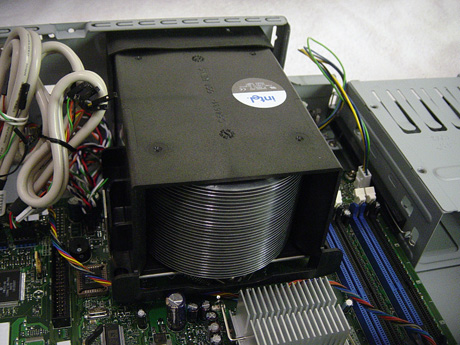Intel's Long Awaited BTX Form Factor
by Purav Sanghani on November 15, 2004 5:31 AM EST- Posted in
- Cases/Cooling/PSUs
Thermals Micro BTX (uBTX)
This is where everything we have heard about the BTX form factor is either proven right or wrong. Intel claims BTX the better design to efficiently cool more components with less equipment while using less power and space. Intel released a virtual press kit on their BTX form factor in April of this year. Unfortunately, the press kit is a little too general to really draw many conclusions, but feel free to judge for yourself.Intel's press kit reports that the BTX design cools the CPU to 2 degrees lower than the ATX form factor while only providing 40 cubic feet per minute, or 40 cfm with our Type I Thermal Module. ATX, on the other hand, requires 150 linear feet per minute, or 150 lfm.
We performed our inch by inch temperature observation with the D915GMH microBTX motherboard and the Pentium 550 CPU in the AOpen B300 which is 15" in width by 13" in depth.

Click to Enlarge
From our results above we see that the temperatures of each square inch of the case are a few degrees higher than those we found on our ATX Ahanix D.Vine 5 chassis. The warmest pocket of air hovers between the PCIe card, Southbridge, Northbridge, and CPU. This area, which averages about 35 degrees, is warmer than the ATX ambient average of about 32 degrees. Intel's whitepaper was not clear on the equipment they used to get the results in their table but from our results, the standard ATX system performs cooler than the BTX system. The microATX system, however, produced temperatures higher than those of the microBTX system.

Click to Enlarge
The results for the core temperatures of each component shown above also tell us that the microBTX equipment does not exactly perform better than the ATX hardware, but for the amount of fans in the system, microBTX is more efficient when it comes to cost of energy and space. With only the CPU's HSF and the power supply's single 80mm fan, the uBTX system performs at temperatures lower than an uATX system with three case fans and a dedicated CPU HSF.

Click to Enlarge
These temperatures are not set in stone for every processor Intel manufacturers or will release in the future. Each will require a different thermal module according to their Thermal Design Power rating. For example, The Pentium 550J will come bundled with a Type I Stacked-fin module whereas the Pentium 560J will come with the Type I Spiral-fin module. Obviously the spiral-fin module will dissipate heat better than the stacked fins.










77 Comments
View All Comments
DerekBaker - Monday, November 15, 2004 - link
#25From here I should think: ">From the picture we see the flow of warm air pulled forward from beyond the VGA card. As it moves towards the front of the case the air flows over the Southbridge and Northbridge passively cooling each chip. We then see from the shades of red the air warms up as it flows through the CPU heatsink then begins to cool as it moves out the front of the case."
http://www.anandtech.com/casecooling/showdoc.aspx?...
Derek
Oxonium - Monday, November 15, 2004 - link
Let's see, a new form factor with new case requirements and STILL no standardized connector for the front Power/Reset/LED's/etc.? I'm all for cooler cases, but a standardized connector for those items is something that should have been implemented years ago.HardwareD00d - Monday, November 15, 2004 - link
#24, who cares since athlons run much cooler and don't need this case form factor.Doormat - Monday, November 15, 2004 - link
I heard a rumor that it wont work with Athlon 64 chips or any type of chip that has the memory controller integrated with the processor, because the distance between the processor and the RAM banks are too far. Anyone confirm this?Superbike - Monday, November 15, 2004 - link
Wow AT is back.phisrow - Monday, November 15, 2004 - link
While I agree that the tweaky enthusiast market doesn't have much to gain at the moment by moving from ATX to BTX, especially as most of them are running A64s or praying-for-death overclocked mobile Athlons, I think there is certainly something to be said for the form-factor. It does seem to be more efficient for cooling than your average ATX(especially for small cases). Even if you are running some PentiumM or a derivative thereof, more efficient is still better. After all, if a given case design can cool a high-end Prescott without deafening its user, it can probably cool a brutally overclocked Pentium M with its fans running at half the speed. For that matter, if the trace length issues aren't actually crippling, I would like to see some A64 motherboards in this format.johnsonx - Monday, November 15, 2004 - link
Visualize an office full of MicroBTX Desktop computers. Visualize the women in the office cupping their hands around the heat exhaust... visualize the overclocking tips flowing around the female staff as they strive to increase heat output... visualize the men pouring sweat, desparately trying to duct-tape the front vent to block the hot Intel Air.I'm sorry, but any spec that seeks to exhaust hot air out the FRONT of any case, whether it be a desktop, tower or SFF, is just plain STUPID.
araczynski - Monday, November 15, 2004 - link
my god, after all these years, they fall back on the packard bell mentality...KristopherKubicki - Monday, November 15, 2004 - link
GTMan: Temperatures were certainly taken with the cases closed.Kristopher
GTMan - Monday, November 15, 2004 - link
I wonder if all those temperature measurements were done with the case open? I would think a case designed for efficient air flow would only perform properly (as designed) when fully assembled!!!